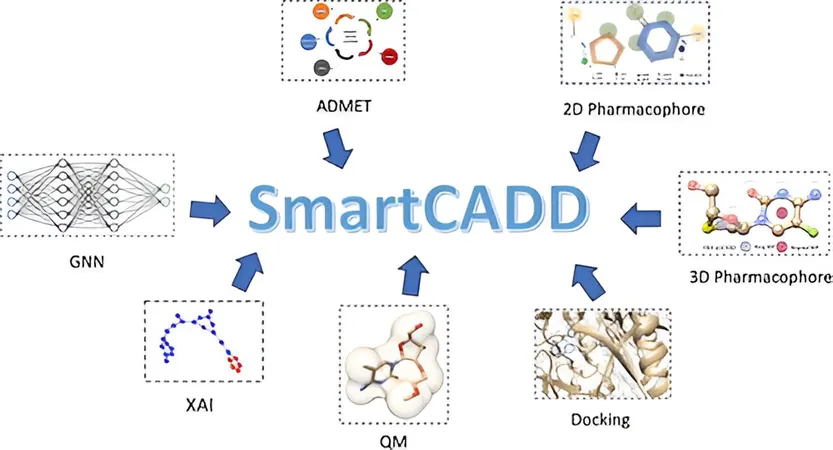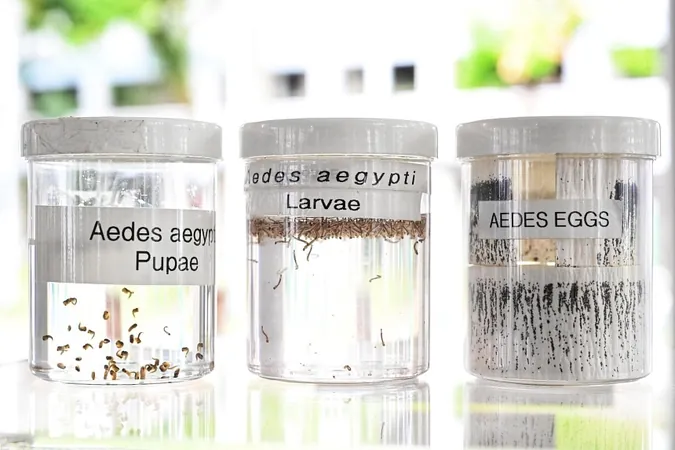
Revolutionizing Drug Discovery: How AI and Quantum Mechanics Are Changing the Game
2024-10-07
Author: Mei
Drug discovery has long been regarded as an arduous jigsaw puzzle, where the intricate shapes of chemical compounds must align perfectly with proteins in the human body to unleash their therapeutic potential. This painstaking process has made the creation of new drugs extraordinarily complex and time-consuming.
However, researchers at Southern Methodist University (SMU) have developed an innovative solution called SmartCADD, an open-source virtual tool that synergizes artificial intelligence, quantum mechanics, and Computer-Assisted Drug Design (CADD) methods. This cutting-edge platform significantly accelerates the screening of chemical compounds, effectively slashing the timelines traditionally associated with drug discovery. Recently featured in the Journal of Chemical Information and Modeling, SmartCADD has shown remarkable efficacy in identifying promising drug candidates for HIV.
The genesis of SmartCADD stems from an interdisciplinary alliance between the chemistry department in Dedman College of Humanities and Sciences and the computer science department in the Lyle School of Engineering at SMU. This collaboration underscores the essence of combining different expertise to innovate within the field of pharmaceutical science.
“There is a pressing need to discover new classes of drugs such as antibiotics, cancer treatments, and antivirals,” stated Elfi Kraka, head of the Computational and Theoretical Chemistry Group (CATCO) at SMU. With the rapid adoption of AI across various sectors, Kraka notes that an initial hesitation to utilize AI in scientific research persists, primarily due to concerns regarding its transparency and the quality of data employed for training. SmartCADD aims to address these challenges, boasting the capability to sift through billions of chemical compounds in just one day, drastically shortening the identification phase for viable drug candidates.
How SmartCADD Operates
SmartCADD employs a harmonious blend of deep learning models, filtering processes, and explainable AI to sift through extensive databases of chemical compounds, effectively pinpointing potential drug leads. It features two primary components: the Pipeline Interface, which aggregates data and manages filtering, and the Filter Interface, which dictates operational parameters for each filter. This systematic design optimizes the evaluation process for chemical compounds, allowing it to forecast how drugs behave in the human body, simulate drug structures through 2D and 3D modeling, and provide rationales for its decisions.
In demonstration studies focused on drugs for HIV treatment, researchers leveraged SmartCADD to analyze data from the MoleculeNet library, creating a comprehensive database consisting of 800 million chemical compounds. From this vast pool, they identified 10 million candidates that could potentially serve as HIV drugs. The tool further refined these options, matching them against existing approved HIV treatments.
While the study predominantly honed in on HIV-related targets, the team emphasized SmartCADD's versatility, indicating that its application could extend to a myriad of other therapeutic areas.
“This user-friendly virtual screening platform delivers researchers a highly integrated and adaptable framework for their drug discovery pipelines,” remarked Corey Clark, assistant professor of computer science and deputy director of research at SMU's Guildhall. “The potential for expanding our chemistry and machine learning capabilities is exhilarating, and we are committed to advancing this work further. The forthcoming phases are poised to exceed our previous accomplishments.”
The Power of Collaboration
The impressive outcomes seen with SmartCADD are a testament to the strength of interdisciplinary collaboration at SMU. In addition to Kraka and Clark, the research team includes chemistry postdoctoral fellow Ayesh Madushanka and computer science graduate student Eli Laird.
“Significant breakthroughs in fields like drug discovery necessitate collaborative efforts to be truly effective,” explained Madushanka. “If the chemistry department had tackled this alone, the end product may not have reached the same level of innovation. Different perspectives refine and elevate ideas.”
Laird underscored the importance of cross-disciplinary research: “Genuine advancements that impact the real world require an expansive view across various fields. This fundamental synergy is a driving force behind my decision to pursue my Ph.D. at SMU. Innovative breakthroughs are often born at the crossroads of diverse disciplines, and that’s exactly where I aim to place my research efforts.”
As the landscape of drug discovery continues to evolve, the fusion of artificial intelligence and quantum mechanics heralds a new era of rapid discovery and innovation. Will SmartCADD pave the way for the next generation of life-saving medications? Only time will tell, but the future looks incredibly promising!


 Brasil (PT)
Brasil (PT)
 Canada (EN)
Canada (EN)
 Chile (ES)
Chile (ES)
 España (ES)
España (ES)
 France (FR)
France (FR)
 Hong Kong (EN)
Hong Kong (EN)
 Italia (IT)
Italia (IT)
 日本 (JA)
日本 (JA)
 Magyarország (HU)
Magyarország (HU)
 Norge (NO)
Norge (NO)
 Polska (PL)
Polska (PL)
 Schweiz (DE)
Schweiz (DE)
 Singapore (EN)
Singapore (EN)
 Sverige (SV)
Sverige (SV)
 Suomi (FI)
Suomi (FI)
 Türkiye (TR)
Türkiye (TR)